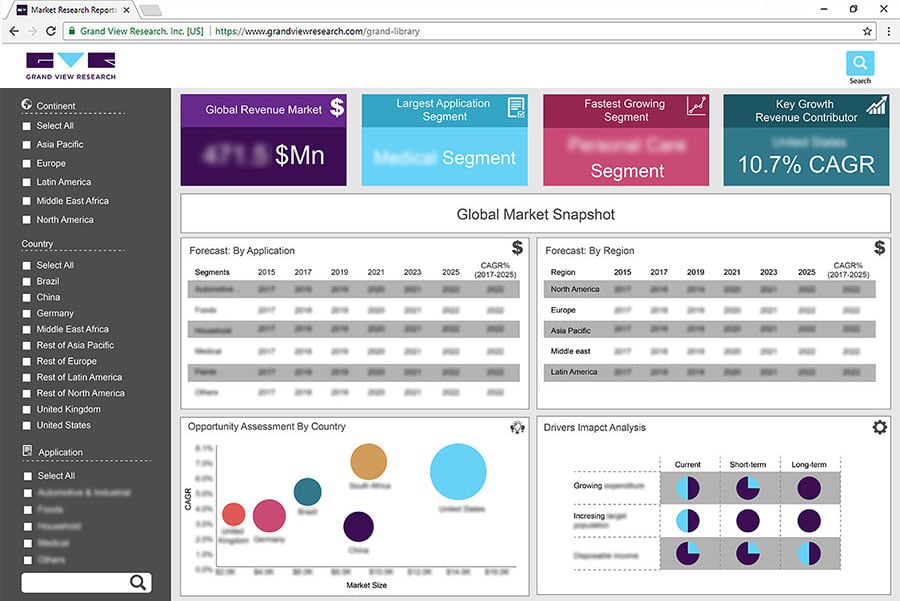- Home
- »
- Communication Services
- »
-
Broadband Services Market Size Report, 2023-2030GVR Report cover
![Broadband Services Market Size, Share & Trends Report]()
Broadband Services Market Size, Share & Trends Analysis Report By Broadband Connection (Fiber Optic, Wireless, Satellite, Cable, DSL), By End User (Business, Household), By Region, And Segment Forecasts, 2023 - 2030
- Report ID: GVR-4-68038-542-7
- Number of Report Pages: 174
- Format: PDF, Horizon Databook
- Historical Range: 2017 - 2021
- Forecast Period: 2023 - 2030
- Industry: Technology
Report Overview
The global broadband services market size was valued at USD 419.44 billion in 2022 and is expected to grow at a compound annual growth rate (CAGR) of 9.7% from 2023 to 2030. Digital transformation of several industry verticals requires broadband services, thereby promoting market growth. For instance, increasing online commerce for retail goods & services, digitalization of hospital records, e-government initiatives, and rapidly rising platforms for media and entertainment content are notably augmenting the market growth. Wireless technology holds immense potential in accelerating the global digital revolution across verticals through productivity enhancements and economic reductions.
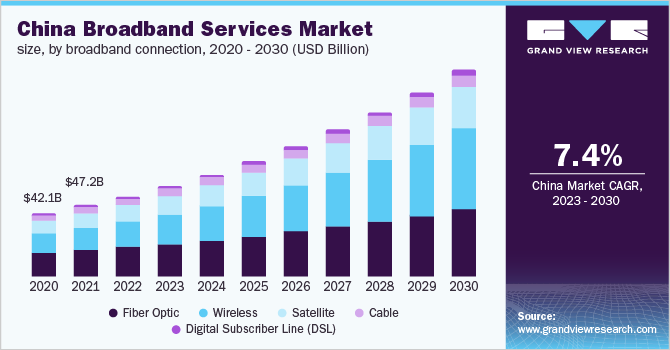
According to the Organization for Economic Co-operation and Development (OECD), surge in the number of wireless subscribers has been a major growth driver for the market. Besides digital transformation in businesses, increased adoption of online learning has not only augmented the need for digital education, but also reflects a strong requirement for uninterrupted broadband connectivity. The market continues to expand at a steady pace, driven by increasing application of broadband in global communication. With the rising trend of global digitalization, governments, business, and individuals are increasingly depending on high-speed seamless internet connections for purposes of information, education, interaction, and entertainment.
Continuously evolving research and development of broadband service to make it more industry-compliant and application-oriented is anticipated to drive the market over the forecast period. The COVID-19 pandemic has affected businesses all over the world by disrupting supply chains, thereby straining the global economy. The current situation-wherein industries are temporarily shut down and people are confined to their homes-has reflected the need for digitalization to stay connected, run businesses, and retain a certain degree of normalcy. Education and fitness business models have rapidly shifted towards online coaching.
Similarly, most offices have adopted a work-from-home strategy. The aforementioned factors, coupled with a sharp surge in internet usage for entertainment factors, have fueled up the growth rate for broadband services over the last few months. Furthermore, most businesses are likely to transform their strategies towards digital channels, thereby augmenting the market.
Broadband Connection Insights
In terms of revenue, the fiber optics segment dominated the market and accounted for the largest revenue share of 34.0% in 2022. This high share is attributable to the capacity of fiber optics to carry superior quality network signals from the operator's equipment directly to an enterprise, business, or household. Fiber networks have been called "futureproof" due to their continuously improving technologies to increase bandwidth according to business needs without the deployment of novel networks. However, the emergence of wireless broadband services poses a strong threat to the fiber optics broadband market.
Wireless broadband service is positioned to demonstrate the fastest growth through the forecast period to become the largest segment among all broadband connections by 2030. The rapid growth is supported by technological advancements and user convenience. Unlike other broadband connections, wireless services use radio waves or Wireless Fidelity (Wi-Fi) instead of cables. The fast-paced evolution of mobile wireless services from 3G to 4G and now, the nascent 5G technology has further ramped up the demand and application of wireless broadband services.
End-user Insights
In terms of revenue and market share, business end user segment captured the largest market share of over 43.0% in 2022. Most businesses require a fast and consistent internet connection to communicate internally with employees and externally with business partners and customers. Nearly all aspects of new-age business models-including marketing and sales, client engagement, and profits analysis-resonates with the demand for broadband service. Furthermore, digital channelization of most business models in tandem with the global digital revolution has further enhanced the application of broadband services across all industry verticals.
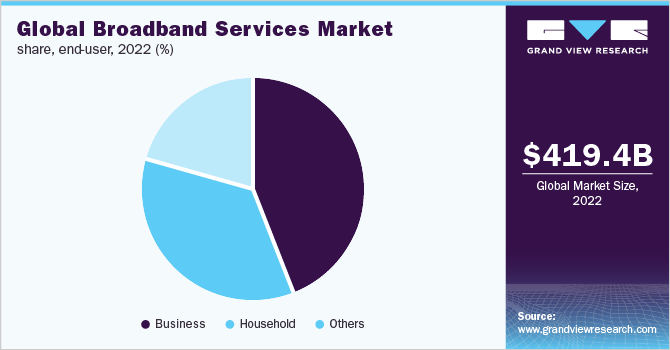
The trend of online learning is speedily gaining momentum as schools, colleges, and universities promptly adopt digital education, thereby requiring a reliable internet connection. Furthermore, the increasing trend of work-from-home practices-that registered a steep incline due to the lockdowns forced by COVID-19 curbing activities-and surge in entertainment and other media content online has enabled large-scale installation of internet services in the household sector. We anticipate household sub-segment to register a double-digit growth through the forecast period.
Regional Insights
The Asia Pacific dominated the market with a share of over 28.0% in 2022, driven by the broad accessibility, technological advancements, and proactive government initiatives. Asia Pacific countries-forerun by China and Japan-spontaneously embrace ultra-fast broadband, thereby propelling the usage rates and enlarging the consumer pool over the next few years. Furthermore, internet services providers continue to offer add-on services at economic rates to attract the middle- and low-income sections of consumers. In addition, the large consumer base in this region and rise in disposable income are notable growth-contributors for the broadband services market.
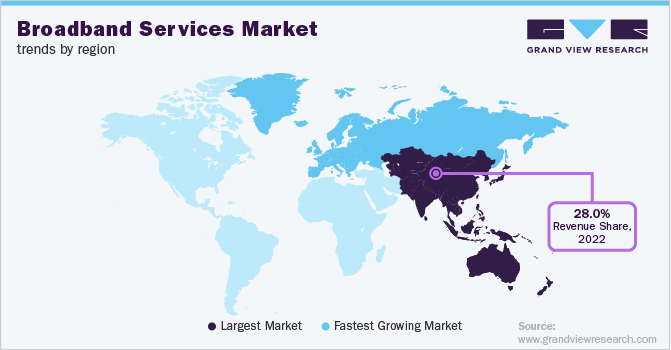
Europe is poised to witness significant growth over the forecast period. According to the European Commission (EC), nearly 96.7% of households in Europe have access to fixed broadband services. The EC intends to transform the region into a Gigabit Society by 2025. In addition, the Broadband Coverage in Europe study has been designed to track the progress of the specified broadband coverage objectives Digital Agenda of Europe-‘Broadband take-up of 50% of households with speeds at least 100 Mbps by 2020’ and ‘Universal Broadband Coverage with speeds at least 30 Mbps by 2020’.
Key Companies & Market Share Insights
The market remains an intensely competitive space, driven by the large number of strategic initiatives involved to accelerate the global digital revolution. The providers in the industry are intensely focusing on improvising the technology to meet the demands of the increasing bandwidth applications, high-speed internet requirements, and user-convenience arising from the bandwidth-intensive applications. For instance, in May 2020, Sky and NBCUniversal launched a business offering that enables customers to purchase Sky's global international news through NBCUniversal's One Platform. The Comcast-NBCUniversal-Sky deal allows marketers to leverage unrivaled content and scale. Some of the prominent players in the broadband services market include:
-
Comcast
-
Time Warner Cable, Inc.
-
Cox Communications, Inc.
-
Singtel
-
AT&T
-
Verizon Communications, Inc.
-
Qwest Communications International, Inc.
-
Embarq
-
Bell Canada Enterprises, Inc.
-
Sprint Nextel
Broadband Services Market Report Scope
Report Attribute
Details
Market size value in 2023
USD 457.62 billion
Revenue forecast in 2030
USD 875.1 billion
Growth Rate
CAGR of 9.7% from 2023 to 2030
Base year for estimation
2022
Historical data
2017 - 2021
Forecast period
2023 - 2030
Quantitative units
Revenue in USD billion and CAGR from 2023 to 2030
Report coverage
Revenue forecast, company ranking, competitive landscape, growth factors, and trends
Segments covered
Broadband connection, end user, region
Regional scope
North America; Europe; Asia Pacific; South America; MEA
Country scope
U.S.; Canada; Mexico; U.K.; Germany; France; China; India; Japan; Brazil; South Korea
Key companies profiled
Comcast; Time Warner Cable, Inc.; Cox Communications, Inc.; Singtel; AT&T; Verizon Communications, Inc.; Qwest Communications International, Inc.; Embarq; Bell Canada Enterprises, Inc.; Sprint Nextel
Customization scope
Free report customization (equivalent up to 8 analyst’s working days) with purchase. Addition or alteration to country, regional & segment scope.
Pricing and purchase options
Avail customized purchase options to meet your exact research needs. Explore purchase options
Segments Covered in the Report
This report forecasts revenue growth at global, regional, and country levels and provides an analysis of the latest industry trends in each of the sub-segments from 2017 to 2030. For the purpose of this study, Grand View Research has segmented the global broadband services market report based on broadband connection, end user, and region:
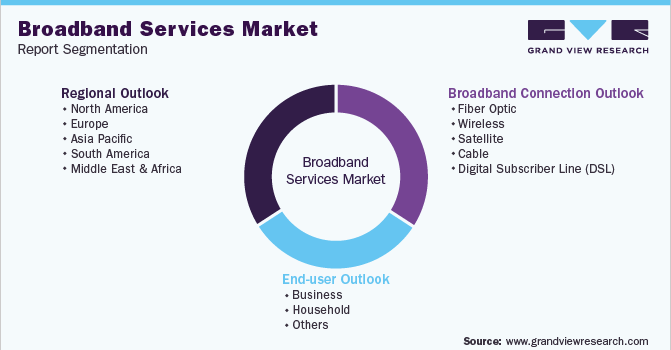
-
Broadband Connection Outlook (Revenue, USD Billion, 2017 - 2030)
-
Fiber Optic
-
Wireless
-
Satellite
-
Cable
-
Digital Subscriber Line (DSL)
-
-
End-user Outlook (Revenue, USD Billion, 2017 - 2030)
-
Business
-
Household
-
Others
-
-
Regional Outlook (Revenue, USD Billion, 2017 - 2030)
-
North America
-
U.S.
-
Canada
-
Mexico
-
-
Europe
-
U.K.
-
Germany
-
France
-
-
Asia Pacific
-
China
-
Japan
-
India
-
South Korea
-
-
South America
-
Brazil
-
-
Middle East and Africa (MEA)
-
Frequently Asked Questions About This Report
b. The global broadband services market size was estimated at USD 419.4 billion in 2022 and is expected to reach USD 457.6 billion in 2023.
b. The global broadband services market is expected to grow at a compound annual growth rate of 9.7% from 2023 to 2030 to reach USD 875.1 billion by 2030.
b. The Asia Pacific dominated the broadband services market with a share of 28.70% in 2022. This is attributable to broad accessibility, technological advancements, and proactive government initiatives in the region.
b. Some key players operating in the broadband services market include COMCAST, AT&T, Verizon, Cox Communications, Inc. among others.
b. Key factors driving the broadband services market growth include digital transformation in businesses, increased adoption of online learning, and a rise in disposable income.
Share this report with your colleague or friend.
![gvr icn]()
NEED A CUSTOM REPORT?
We can customize every report - free of charge - including purchasing stand-alone sections or country-level reports, as well as offer affordable discounts for start-ups & universities. Contact us now
![Certified Icon]()
We are GDPR and CCPA compliant! Your transaction & personal information is safe and secure. For more details, please read our privacy policy.
We are committed towards customer satisfaction, and quality service.
"The quality of research they have done for us has been excellent."





